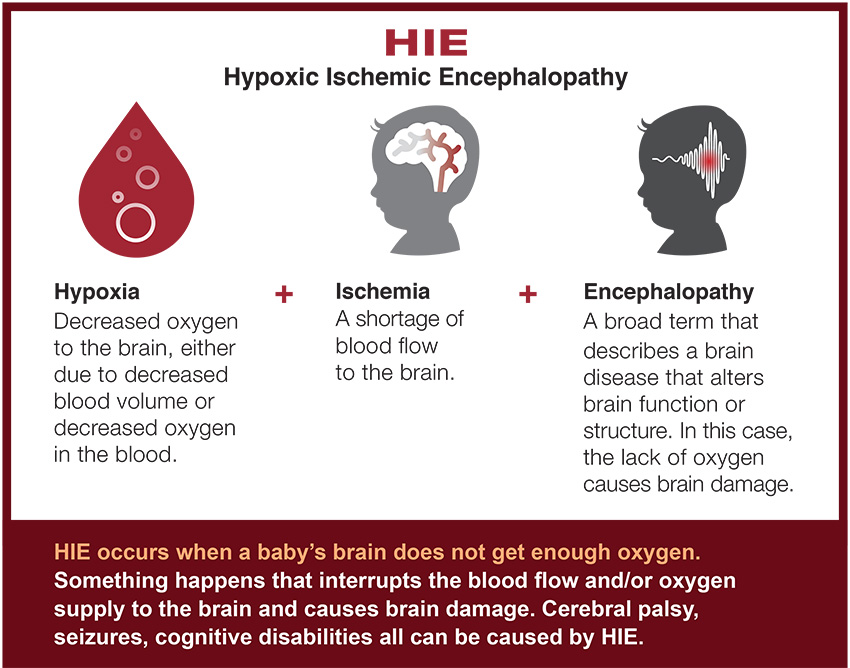Ohio HIE Lawyers Pursue Brain Damage Claims on Behalf of Newborns
Infant hypoxic ischemic encephalopathy (HIE) is a dangerous condition that may develop during or after birth
According to one statistic, hypoxic ischemic encephalopathy, or HIE for short, affects 20 out of 1000 babies. In premature babies, the number is much higher—around 60 percent are affected. HIE occurs when a baby’s brain does not get enough oxygen. It is a serious medical condition that must be addressed immediately by medical professionals. If a medical professional does not recognize or treat HIE in a timely manner, the baby could suffer permanent serious injury or death. At The Eisen Law Firm, our birth negligence attorneys hold medical professionals accountable when their errors cause serious injuries.

When does HIE occur?
In most cases, HIE occurs right before or right after a baby is born. HIE that is caused by asphyxia, or a lack of oxygen, is the most commonly cited cause of newborn death in the United States. It is also frequently cited as a cause of cerebral palsy, impairment, and disability.
How do I know if my baby had HIE?
Your baby may have exhibited several signs of distress before or immediately after birth. Many of these signs are linked to HIE. These include:
-
The presence of meconium in the amniotic fluid
-
Weak muscle tone
-
Low heart rate
-
Weakened breathing, or a complete lack of breathing
-
Skin that is bluish in color or pale
-
Increased acid in the blood
There are several types of diagnostic tests that may be used to determine if a baby is suffering from HIE as well. These include:
-
Electroencephalogram (EEG)
-
Ultrasounds
-
Electrocardiograms (EKG)
-
MRI scans
-
CT scans
-
Blood tests (including testing of umbilical cord blood)
If your baby exhibited signs of HIE, but medical professionals did not take immediate action, you and your family may be entitled to compensation.
What increases the risk of HIE?
Certain complications and conditions in pregnancy may increase the risk of HIE. These may include:
-
Poor blood circulation (to the placenta)
-
Diabetes accompanied by vascular disease
-
Lung malformations
-
Cardiac conditions
-
Infections
-
Significant fetal anemia
-
Alcohol and substance abuse
During labor, the following complications may cause HIE:
-
Low maternal blood pressure
-
Umbilical cord complications
-
Long labor
-
Abnormal fetal position
-
Placental or uterine rupture
-
Bleeding from the placenta
After the baby is born, several conditions may cause HIE, including:
-
Heart or lung diseases
-
Prematurity
-
Low blood pressure
-
Trauma to the brain or skull
-
Congenital brain defects
-
Sepsis
-
Meningitis
-
Other infections
Although HIE occurs without warning at times, if your medical professional did not properly monitor your pregnancy, birth, or delivery, and your baby suffered from HIE, you may be entitled to compensation.
How long do I have to file a claim?
Ohio has a one-year statute of limitations in place for medical negligence claims. However, this statute of limitations is “tolled” until the injured child’s eighteenth birthday. This means that the one-year period doesn’t begin running until the child turns eighteen. Therefore, the time limit to file suit for injury to a child is the child’s nineteenth birthday.
Still, it is better to pursue legal action with the assistance of an experienced birth injury attorney sooner rather than later, as much of the evidence and the witnesses needed to pursue a claim may not be available after several years.
Call The Eisen Law Firm today to schedule a free consultation
At The Eisen Law Firm, we understand the devastating impact birth injuries have on your family. We are prepared to fight for you both inside and outside of the courtroom. To schedule a free consultation with our experienced legal team, call 216-687-0900 or contact us online.
